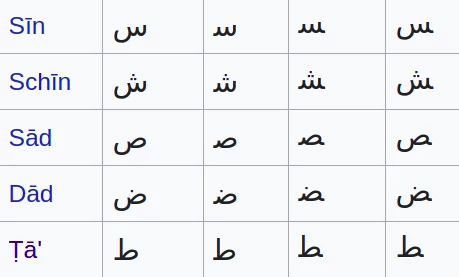How to type Arabic characters
Arabic characters can be entered in three ways:
- Click with the mouse on the keys of the online keyboard
- Write "phonetically" with your own keyboard: Select keyboard input "phonetic" - see conversion rules
- Write "international" with your own keyboard (qwerty layout): Select keyboard input "international"
Konvertierungsregeln
| Latin | Arabic |
|---|---|
| a | ا |
| aa | آ |
| a- | إ |
| -a | أ |
| l | ل |
| s | س |
| ss | ش |
| Latin | Arabic |
|---|---|
| y | ي |
| yy | ى |
| yyy | ئ |
| w | و |
| ww | ؤ |
| m | م |
| n | ن |
| Latin | Arabic |
|---|---|
| la | لا |
| b | ب |
| h | ه |
| hh | ة |
| r | ر |
| f | ف |
| k | ك |
| Latin | Arabic |
|---|---|
| S | ص |
| SS | ض |
| T | ط |
| TT | ظ |
| H | ح |
| HH | خ |
| j | ج |
| Latin | Arabic |
|---|---|
| d | د |
| dd | ذ |
| t | ت |
| tt | ث |
| g | ع |
| gg | غ |
| q | ق |
| Latin | Arabic |
|---|---|
| z | ز |
| ڨ | |
| kk | ڭ |
| p | پ |
| v | ڢ |
| ff | ڤ |
| c | چ |
| Latin | x. | xw | xa | xi | xu | xan | xin | xun | - |
|---|---|---|---|---|---|---|---|---|---|
| Arabic | ْ | ّ | َ | ِ | ُ | ً | ٍ | ٌ | ء |
Arabic script
The following applies to the Arabic script of the Arabic language:
- it is written from right to left
- the alphabet contains only consonants and 3 letters for long vocals
- the letters in a word are connected to each other
- each letter has a different shape at the beginning, middle and end of a word.
Arabic virtual keyboard
On this Arabic keyboard you can type Arabic characters. The Arabic keyboard contains all Arabic letters of a real keyboard.
Usefull keyboard tools
| Tool | Description | |
|---|---|---|
| Text2Speech | You can listen to your Arabic text | |
| Grammar checker | You can run a grammar check on your Arabic text. | |
| | Voice input | Your voice is converted into Arabic text while you speak (Possible with the browsers: Chrome, Edge and Safari) |
| Arabic translation | You can use the Arabic translator to translate the text into a variety of other languages, such as German, Spanish etc. |
Arabic audio samples
| en. | ar. | play |
|---|---|---|
| dog | كلب (كَلْب) |  |
| work | عمل (عَمَلٌ) |  |
| to make | عمل (عَمِلَ) |  |
| beautiful | جميل (جَمِيلٌ) |  |
| keyboard | لوحة المفاتيح (لوحة المفاتيح) |  |
| en. | ar. | play |
|---|---|---|
| cat | قطة (قِطَّة) |  |
| war peace | حرب (حَرْب) سلام (سَلاَمٌ) |  |
| to buy | اشترى (اِشْتَرَى) |  |
| large | كبير (كَبِيرٌ) |  |
| to translate | يترجم (يُتَرْجِم) |  |
The Arabic script
* The Arabic Alphabet (Introduction)
* Auxiliary signs in the Arabic script
* Shapes of the letters
* All letters with all shapes
* Frequency of Arabic letters
* Arabic numerals
* Arabic words in English
The Arabic Alphabet
The Arabic alphabet consists of 28 letters: Three of them are long vowels, the rest are all consonants. Auxiliary signs can be used for short vowels.
The three long vowels are:
- long a: Alif ا (in the final position also short a: ى )
- long i or e: Ya ي
- long u or o: Waw و
Ya and Waw are also called semivowels and semiconsonants, respectively, because they are pronounced at the beginning of a syllable like the German j ي and like the English w و, respectively.
In Arabic, letters are written and read from right to left. Although there is no distinction between upper and lower case, the individual letters are nevertheless of different sizes.
The Arabic alphabet is also used for other non-Arabic languages such as Persian and Urdu, only with slight changes and additions to the alphabet. For example, the Persian alphabet includes four additional letters. In addition, two letters of the basic Arabic alphabet have been slightly modified. See Persian keyboard.
Auxiliary signs in the Arabic script
The auxiliary signs have different functions, they are placed above or below the Arabic letter.
As auxiliary signs there are:
3 Vowel signs
| Fatha (short a) above | Kasra (short i or e) below | Damma (short u or o) above |
| َ | ِ | ُ |
1 Gemination sign
The sign shadda is used to mark long consonants or double consonants and is placed over the consonant:ّ
3 signs for nominal endings
| Fathatan (-an) | Kasratan (-in) | Dammatan (-un) |
| ً | ٍ | ٌ |
Other signs
Other signs such as the sukun above a consonant to indicate that the consonant is not followed by a vowel:ْ
Examples with vocalization
| Arabic | نبل | نلبث | للبنت |
| Arabic vocalized | نَبْلُ | نَلْبَثُ | لِلْبِنْتِ |
| transliteration | nablu | nalbathu | lilbinti |
Shapes of the letters
Each letter has up to four different shapes: Isolated shape, initial shape, medial shape and final shape.
For example, the letter kāf ك has these four shapes, depending on where it is in the word:
- Isolated shape: ك
- Initial shape: كـ
- Medial shape: ـكـ
- Final shape: ـك
For example, the letter Alif ا has only two shapes: One shape, which is isolated and used for the beginning of a word, because Alif is basically not connected to the left, and a second shape ﺎ, which is used in the medial and at the end of the word.
Other letters that have only two shapes (isolated/initial vs. medial/final) are: Dhāl ذ, Dāl د, Zāy ز, Rā’ ر und Wāw و
So the mentioned 6 letters have no explicit initial and medial shape. At the beginning and in the middle of the word, the isolated shape without the connecting stroke to the left is used instead. The writing flow, of the otherwise continuous italic writing, is interrupted. This serves to be able to distinguish the individual letters from each other when reading the word:
If, for example, the Alif ا existed with an initial shape (with a connecting stroke to the left), then it would not be possible to distinguish it from the initial shape of the Lām لـ.
All other letters have four shapes. They are presented in the next section.
Knowing these shapes is important when reading or handwriting the Arabic script. When writing on the computer, it is not necessary to know the different shapes, because the font provided by the browser or the program automatically takes over the transformation of the isolated shape into the correct shape.
All letters with all shapes

4 different shapes of an Arabic letter
Frequency of Arabic letters
By far the most commonly used Arabic letters are:
- Alif ﺍ (ca. 12 %)
- Lām ﻝ (ca. 12 %)
It is the two letters that appear in the word Allah الله.
| ﻪ | ﻠ | ﻟ | ا |
| Final shape | Medial shape | Initial shape (!) | Isolated shape |
| Hā' | Lām | Lām | Alif |
Ligature Lām-Alif
In an Arabic word, when the Lām ﻝ is directly followed by the Alif ﺍ, together they form the ligature لا (Lām-Alif). The font handles the conversion of Lām and Alif to Lām-Alif. The Lām-Alif also exists with auxiliary signs. You can find this ligature as a separate key on the keyboard.
This ligature is obligatory in the printed script. In handwritten script, other ligatures are used that allow for smoother writing.
Other common letters with a frequency of 4-7% are:
| Bā' | ب |
| Rā' | ر |
| ʿAin | ع |
| Mīm | م |
| Nūn | ن |
| Hā' | ه |
| Wāw | و |
| Yā' | ي |
Arabic numerals
Before the introduction of Indian numerals into the Arabic script in the 9th century, the Arabic letters were also used for numerical values. Some letters stood for digits, some for tens, some for hundreds.
Today's Arabic numerals are written from left to right in Arabic. Our Arabic numerals (0..9) in the Latin alphabet come from the Western Arabic numerals of that time. The numerals in the Arabic script, on the other hand, come from the Eastern Arabic numerals of the time - which is why they look somewhat different from the numerals in the Latin alphabet.
| 0 | 1 | 2 | 3 | 4 | 5 | 6 | 7 | 8 | 9 |
| ٠ | ١ | ٢ | ٣ | ٤ | ٥ | ٦ | ٧ | ٨ | ٩ |
Arabic words in English
The table shows examples of English words of Arabic origin.
| English | sugar | safari |
|---|---|---|
| transliteration | sukkar | safar (engl. journey) |
| Arabic | سكر | سفر |
| Single letter shapes | ﺳ ﻜ ﺮ | ﺳ ﻔ ﺮ |
There are numerous other words of Arabic origin in English, including Alcohol, General, Hashish, Coffee, Mattress, Magazine, Sofa.
Arabic language tools
Text translator English to Arabic
If you want to translate an English text to Arabic, you can use the translator on fluentwords.net:
Text translator Arabic to English
If you want to translate an Arabic text to English, you can use the translator on fluentwords.net:
English-Arabic and German-Arabic Proverbs
On fluentwords.net you will find many billingual idioms and proverbs English-Arabic and German-Arabic. You can also listen to the proverbs.
 Albanian keyboard online
Albanian keyboard online Arabic keyboard online
Arabic keyboard online Armenian keyboard online
Armenian keyboard online Assamese keyboard online
Assamese keyboard online Bengali keyboard online
Bengali keyboard online Bosnian keyboard online
Bosnian keyboard online Bulgarian keyboard online
Bulgarian keyboard online Danish keyboard online
Danish keyboard online English keyboard online
English keyboard online English keyboard online
English keyboard online French keyboard online
French keyboard online Greek keyboard online
Greek keyboard online Hebrew keyboard online
Hebrew keyboard online Icelandic keyboard online
Icelandic keyboard online Italian keyboard online
Italian keyboard online Japanese keyboard online
Japanese keyboard online Cambodian keyboard online
Cambodian keyboard online Croatian keyboard online
Croatian keyboard online Kurdish (Kurmanji) keyboard
Kurdish (Kurmanji) keyboard Persian/Farsi keyboard online
Persian/Farsi keyboard online Polish keyboard online
Polish keyboard online Portuguese keyboard online
Portuguese keyboard online Romanian keyboard online
Romanian keyboard online Russian keyboard online
Russian keyboard online Serbian keyboard online
Serbian keyboard online Slovakian keyboard online
Slovakian keyboard online Slovenian keyboard online
Slovenian keyboard online Spanish keyboard online
Spanish keyboard online Sundanese keyboard online
Sundanese keyboard online Thai keyboard online
Thai keyboard online Tibetan keyboard online
Tibetan keyboard online Czech keyboard online
Czech keyboard online Turkish keyboard online
Turkish keyboard online Urdu keyboard online
Urdu keyboard online